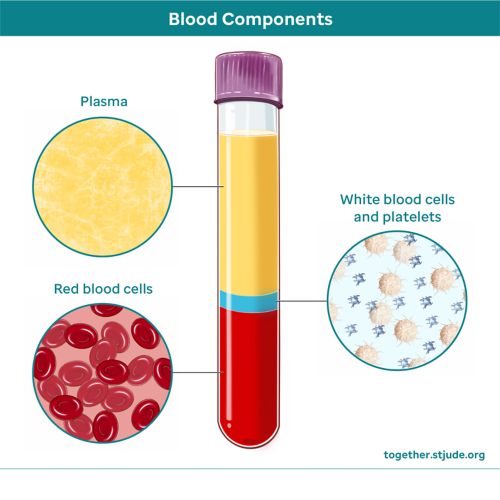What are blood disorders?
Blood disorders are health conditions that keep one or more parts of the blood from working properly. Some blood disorders are mild. Others can be life threatening. Symptoms of blood disorders depend on the part of blood affected and the severity of the condition. Your child’s treatment will depend on their specific diagnosis.
Find information on types of blood disorders.
Blood is made up of several parts. These include:
- Red blood cells that carry oxygen. Red blood cells have an iron-rich protein called hemoglobin. Hemoglobin carries oxygen from the lungs to the body's organs and tissues. Red blood cells also help the body get rid of waste products.
- Platelets that help the blood to clot to prevent or stop bleeding.
- White blood cells that fight infections and protect against germs.
- Plasma or the blood's liquid part. It contains water, proteins, and substances that help blood clot.
Symptoms of blood disorders
The symptoms of blood disorders vary widely depending on the specific disorder.
Common signs and symptoms of blood disorders include:
- Feeling weak or more tired than usual (fatigue)
- Feeling dizzy or lightheade
- Pale skin
- Increased heart rate
- Unexplained bruising or bleeding
- Getting sick more often than usual
- Joint or muscle pain
- Trouble breathing or feeling out of breath
Causes of blood disorders
Blood disorders can have many different causes. These include:
- Gene changes: Many blood disorders are caused by gene changes, which may be inherited (passed down in families).
- Environmental factors: Exposure to certain chemicals or toxins can lead to some blood disorders.
- Autoimmune conditions: The immune system (the body’s defense system that protects against germs) sometimes attacks blood cells by mistake.
- Bone marrow problems: Blood cells are made in the bone marrow, the soft inner portion of bones. If the marrow does now work properly, it can lead to blood disorders.
Medicines, infections, diseases, and other factors can also contribute to blood disorders. In some cases, the cause of the blood disorder may be unknown.
Diagnosis of blood disorders
Blood disorders are diagnosed based on your child’s medical history, physical exam, and lab tests. Your care provider may ask you about any changes in bleeding or bruising, recent illnesses, or medicines your child is taking.
Lab tests for blood disorders may include:
- Complete blood count (CBC) to measure the number and size of the blood cells
- Blood smear to see the size and shape of blood cells
- Blood tests to measure iron, hemoglobin, and other proteins
- Tests to measure how blood clots
- Tests to measure kidney and liver function
- Bone marrow aspiration and biopsy to look at the number and size of cells found in a bone marrow sample
- Genetic testing to check for inherited disorders or gene changes
Other tests may look at specific chemicals or other aspects of blood function. Your care team may do other tests to check for underlying medical conditions that can cause blood disorders.
Treatments for blood disorders
Children with blood disorders need specialized medical care. A hematologist is a doctor who treats blood disorders.
Your child’s care team will create a treatment plan for your child. Treatment for blood disorders depends on the type and severity of the condition.
Treatments for blood disorders may include:
- Lifestyle changes, such as diet, exercise, or avoiding certain activities or conditions that can worsen symptoms
- Medicines to manage symptoms or treat the underlying cause of the disorder.
- Blood transfusions to provide whole blood or blood products
- Therapeutic apheresis procedures, such as red blood cell exchange or therapeutic plasma exchange
- Stem cell (bone marrow) transplant to replace a patient’s blood-forming stem cells with healthy ones from a donor
- Gene therapy to add, change, or repair genes in a patient’s stem cells
Living with blood disorders
Some blood disorders are temporary and go away completely. Other disorders may be lifelong and need ongoing care. Proper management is important to ensure the best quality of life for your child. Always follow your care team’s medical advice.
If your child has a blood disorder, be sure to:
- Encourage healthy habits: Help your child develop a healthy lifestyle by getting enough sleep, physical activity, and healthy foods. Be sure your child drinks enough fluids to prevent dehydration. Avoid activities that could be harmful, like smoking, vaping, and drug or alcohol use.
- Get regular medical care: Keep all appointments and get tests as recommended to monitor your child’s condition. Stay up to date on vaccines and understand your child’s risk for infection or other health problems.
- Give medicines as instructed: Talk to your health care provider or pharmacist if you have questions about your child’s medicines.
- Support emotional health and well-being: Teach healthy ways to manage stress and cope with problems. Get support from your care team, family, friends, or support groups to help meet specific needs and overcome challenges.
Questions to ask your care team
—
Reviewed: September 2024




